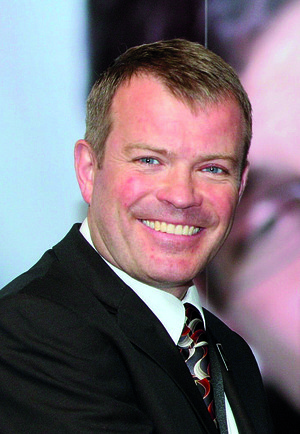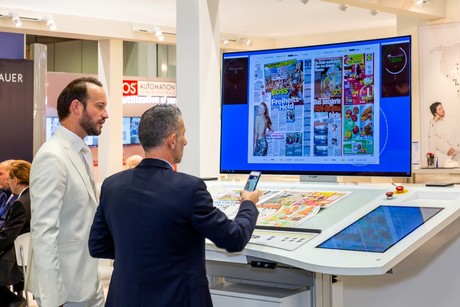Why should a newspaper publisher or printer consider investing in digital printing today?
Publishers can no longer rely on the traditional newspaper business model to generate profitability. Dynamic production, such as the addition of unique competition numbers, localised news, focussed adverts or even just short run digitally printed products, is a way organisations can add value to newspaper production while increasing efficiency.
We have worked with a number of leading newspaper publishers around the word from Miller Newsprint and Axel Springer to the latest high profile deal announced with News UK to help them cost effectively differentiate their product portfolio. We have also helped them ensure they stand out from their competition with a profitable business-winning service that supports client acquisition and retention and improves their bottom line.
Our solutions include the KODAK VERSAMARK VL4200 Printing System capable of full-page high resolution digital colour variability and the KODAK PROSPER S30 Imprinting System for the addition of variable data elements.
To grow profitably, we believe newspaper printers and publishers must offer more value to their readers and advertisers, integrate web and mobile platforms as a channel to sell their content, and improve their return on existing offset presses by developing new commercial business. Digital printing can help to achieve all of these goals.
What is your business vision for digital printing in the newspaper sector?
Our vision is to provide the technology and services to make newspapers a new media for targeted marketing, while maintaining their mass market appeal. To survive, newspapers and their publishers must manage seemingly contradictory objectives: cost cutting and consolidation on the one hand and new content and printing value on the other hand.
We want to help our customers revolutionize their printing approach with dynamic content with easy-to-use, latest-generation systems offering minimum operator effort, monitoring and intervention to help increase efficiencies to improve productivity and capital costs. We are talking to them about how, with our systems, they can address content issues from full-pages to variable codes plus how they can significantly impact their day-to-day production capabilities and costs with our long-run, environmentally conscious plates. We are keen to provide customers with a choice of the amount of variable data they can offer and therefor the different ways they can support newspapers.
Helping our solutions work day-to-day and job-to-job is the wobe team's WNEWSNET Workflow. It manages digital production data in a newspaper prepress department to facilitate automation of plate production, data control and data processing. It is scalable so can grow as customers grow providing a support path to expansion.
What are your requirements with regard to inks and paper? Is it possible to use consumables from different suppliers?
Our process and specialty inks offer one of the broadest spectrums in the industry. They have been developed, tested and manufactured as an integral component for KODAK VERSAMARK Printing Systems, KODAK VERSAMARK Imprinting Systems, KODAK PROSPER Presses and KODAK PROSPER S-Series Imprinting Systems. Designed to work with the entire printing system, the printhead, the system’s color reproduction software, drying process, speed and more are all optimized by the controller to produce maximum printing results with the optimal amounts of ink coverage. We believe third-party ink developers cannot offer this level of precision and confidence. Unlike third party ink ours offer peace of mind in knowing the equipment will be protected, the job will run smoothly, and the results will look outstanding.
Kodak Stream inkjet technology is a very flexible writing system that allows newspapers to use standard offset papers and even print on glossy papers. This helps keep costs low and inventory management simple. To provide these benefits, Stream, which is brought to market under the Kodak Prosper brand, uses a carefully matched writing system that combines specially developed inks and fluids with Kodak's long-lasting inkjet printing heads. These benefits wouldn't be possible if a customer tried to use a third party ink.
Inkjet inks are know as difficult to de-ink. Is there a problem on the horizon and if so, what could be the solution?
First, the claims from some testing agencies regarding recyclability of prints made with dye based aqueous ink jet inks are misleading and not entirely accurate. To the best of Kodak’s knowledge there have been no substantiated examples of paper recyclers unable to process ink jet printed papers.
Recycling systems are dynamic and have evolved over many years and we continue to monitor the recycling industry and will fully support the use of our products and technologies. We have recently formed an industry alliance with other inkjet companies to support research into improving paper recycling technology.
Secondly, our ink jet inks are compliant with all existing regulatory agencies worldwide. We use high quality dyes that have the same or higher purity levels as found in the food and pharmaceutical industries. Some inks contain up to 95% water in their formulation and for this reason are preferred from an environmental standpoint.
Studies with industry experts confirm that most waterbased inkjet inks can be successfully deinked up to 10% in the recovered paper mix. For imprinting with inkjet, we do not anticipate any issues in commercial deinking, now or in the future. For full inkjet printed newspapers, this 10% threshold is a function of market adoption rates and paper recovery methods. Kodak is also a member of the Digital Print Deinking Alliance (http://thedpda.org/).
Kodak, a charter member of the Sustainability Institute at Rochester Institute of Technology, is a recognized industry leader in sustainability initiatives. We were named as one of theTop100 Most Sustainable Companies and continue to support environmental activities such as our Printer’s EnviroServices Programs.



